Analyzing the Effect of Leadership Role on Organizational Performance
VerifiedAdded on 2023/06/12
|13
|4474
|86
Report
AI Summary
This report delves into the styles of leadership, their roles and types, leadership theories, and their impact on organizational performance. It highlights the importance of leadership in influencing people towards organizational goals and discusses transformational, transactional, and laissez-faire leadership styles. The report also examines the role of organizational culture in shaping leadership styles and affecting performance. It further explores how leaders can drive performance through strategic planning, process management, and by serving as role models. The research methods section outlines the hypothesis, research framework, survey questions, and data collection methods used to analyze the impact of leadership roles on organizational performance. The document concludes by emphasizing the significance of effective leadership practices in enhancing team performance and fostering a culture of dedication and management.
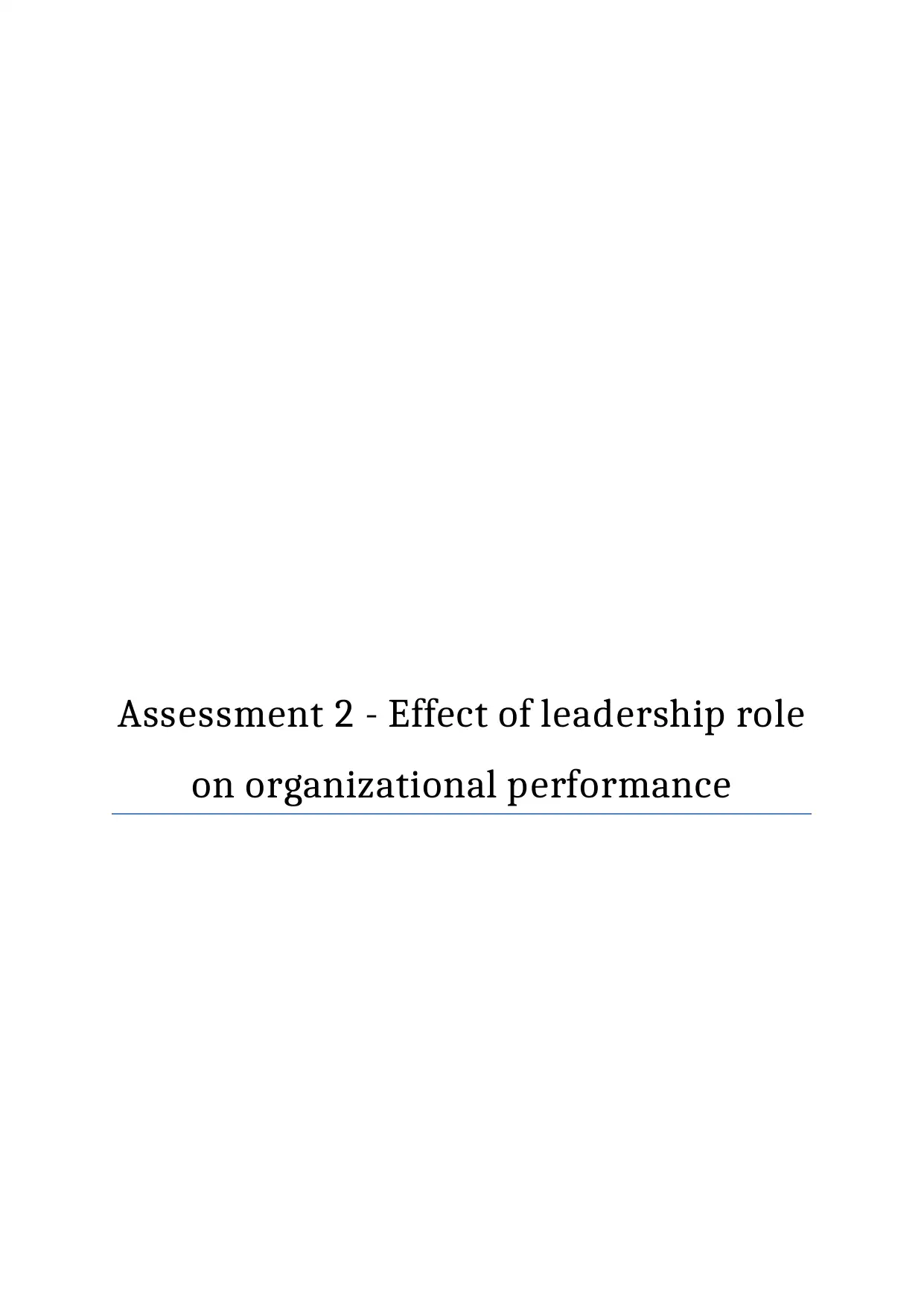
Assessment 2 - Effect of leadership role
on organizational performance
on organizational performance
Paraphrase This Document
Need a fresh take? Get an instant paraphrase of this document with our AI Paraphraser
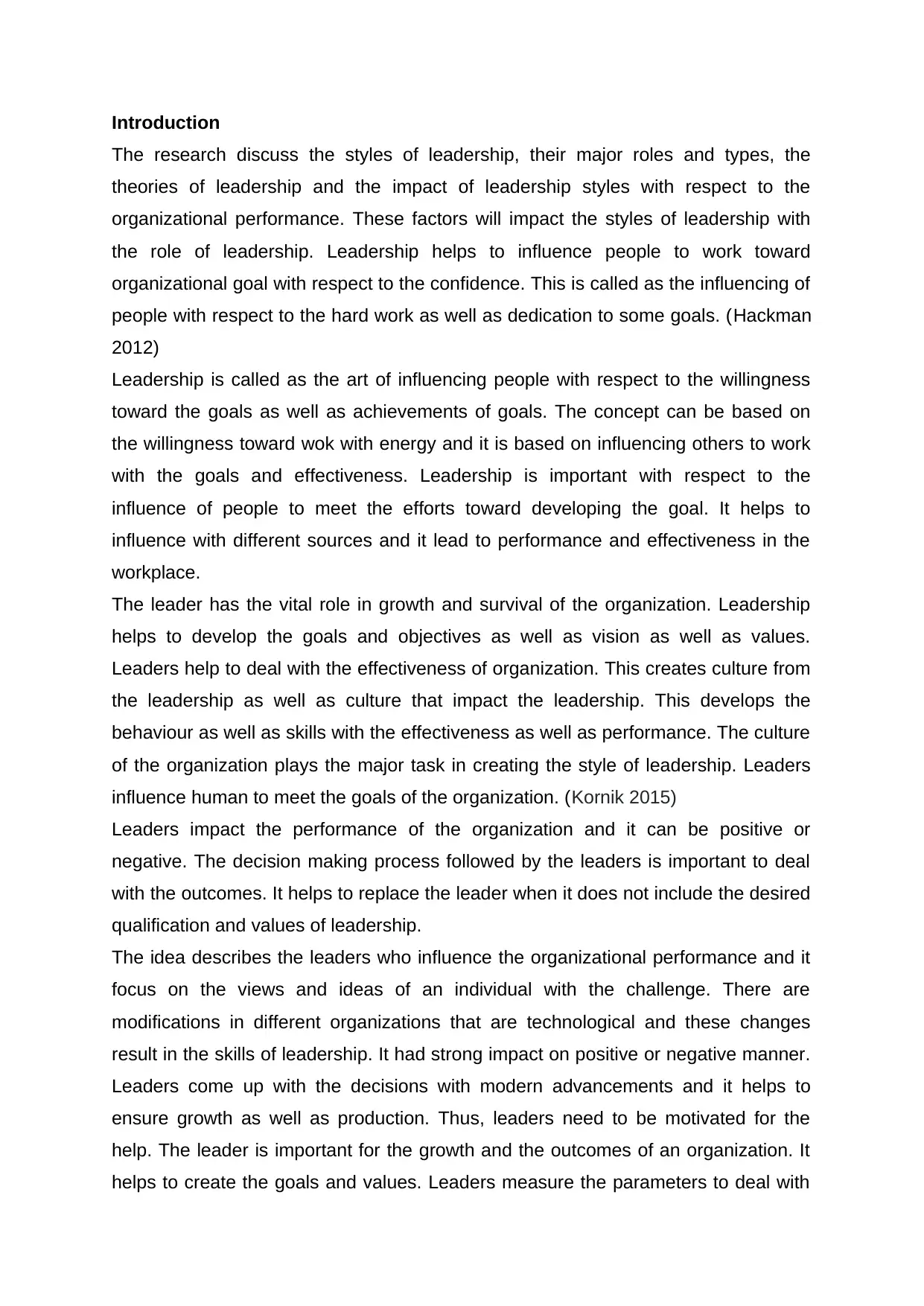
Introduction
The research discuss the styles of leadership, their major roles and types, the
theories of leadership and the impact of leadership styles with respect to the
organizational performance. These factors will impact the styles of leadership with
the role of leadership. Leadership helps to influence people to work toward
organizational goal with respect to the confidence. This is called as the influencing of
people with respect to the hard work as well as dedication to some goals. (Hackman
2012)
Leadership is called as the art of influencing people with respect to the willingness
toward the goals as well as achievements of goals. The concept can be based on
the willingness toward wok with energy and it is based on influencing others to work
with the goals and effectiveness. Leadership is important with respect to the
influence of people to meet the efforts toward developing the goal. It helps to
influence with different sources and it lead to performance and effectiveness in the
workplace.
The leader has the vital role in growth and survival of the organization. Leadership
helps to develop the goals and objectives as well as vision as well as values.
Leaders help to deal with the effectiveness of organization. This creates culture from
the leadership as well as culture that impact the leadership. This develops the
behaviour as well as skills with the effectiveness as well as performance. The culture
of the organization plays the major task in creating the style of leadership. Leaders
influence human to meet the goals of the organization. (Kornik 2015)
Leaders impact the performance of the organization and it can be positive or
negative. The decision making process followed by the leaders is important to deal
with the outcomes. It helps to replace the leader when it does not include the desired
qualification and values of leadership.
The idea describes the leaders who influence the organizational performance and it
focus on the views and ideas of an individual with the challenge. There are
modifications in different organizations that are technological and these changes
result in the skills of leadership. It had strong impact on positive or negative manner.
Leaders come up with the decisions with modern advancements and it helps to
ensure growth as well as production. Thus, leaders need to be motivated for the
help. The leader is important for the growth and the outcomes of an organization. It
helps to create the goals and values. Leaders measure the parameters to deal with
The research discuss the styles of leadership, their major roles and types, the
theories of leadership and the impact of leadership styles with respect to the
organizational performance. These factors will impact the styles of leadership with
the role of leadership. Leadership helps to influence people to work toward
organizational goal with respect to the confidence. This is called as the influencing of
people with respect to the hard work as well as dedication to some goals. (Hackman
2012)
Leadership is called as the art of influencing people with respect to the willingness
toward the goals as well as achievements of goals. The concept can be based on
the willingness toward wok with energy and it is based on influencing others to work
with the goals and effectiveness. Leadership is important with respect to the
influence of people to meet the efforts toward developing the goal. It helps to
influence with different sources and it lead to performance and effectiveness in the
workplace.
The leader has the vital role in growth and survival of the organization. Leadership
helps to develop the goals and objectives as well as vision as well as values.
Leaders help to deal with the effectiveness of organization. This creates culture from
the leadership as well as culture that impact the leadership. This develops the
behaviour as well as skills with the effectiveness as well as performance. The culture
of the organization plays the major task in creating the style of leadership. Leaders
influence human to meet the goals of the organization. (Kornik 2015)
Leaders impact the performance of the organization and it can be positive or
negative. The decision making process followed by the leaders is important to deal
with the outcomes. It helps to replace the leader when it does not include the desired
qualification and values of leadership.
The idea describes the leaders who influence the organizational performance and it
focus on the views and ideas of an individual with the challenge. There are
modifications in different organizations that are technological and these changes
result in the skills of leadership. It had strong impact on positive or negative manner.
Leaders come up with the decisions with modern advancements and it helps to
ensure growth as well as production. Thus, leaders need to be motivated for the
help. The leader is important for the growth and the outcomes of an organization. It
helps to create the goals and values. Leaders measure the parameters to deal with
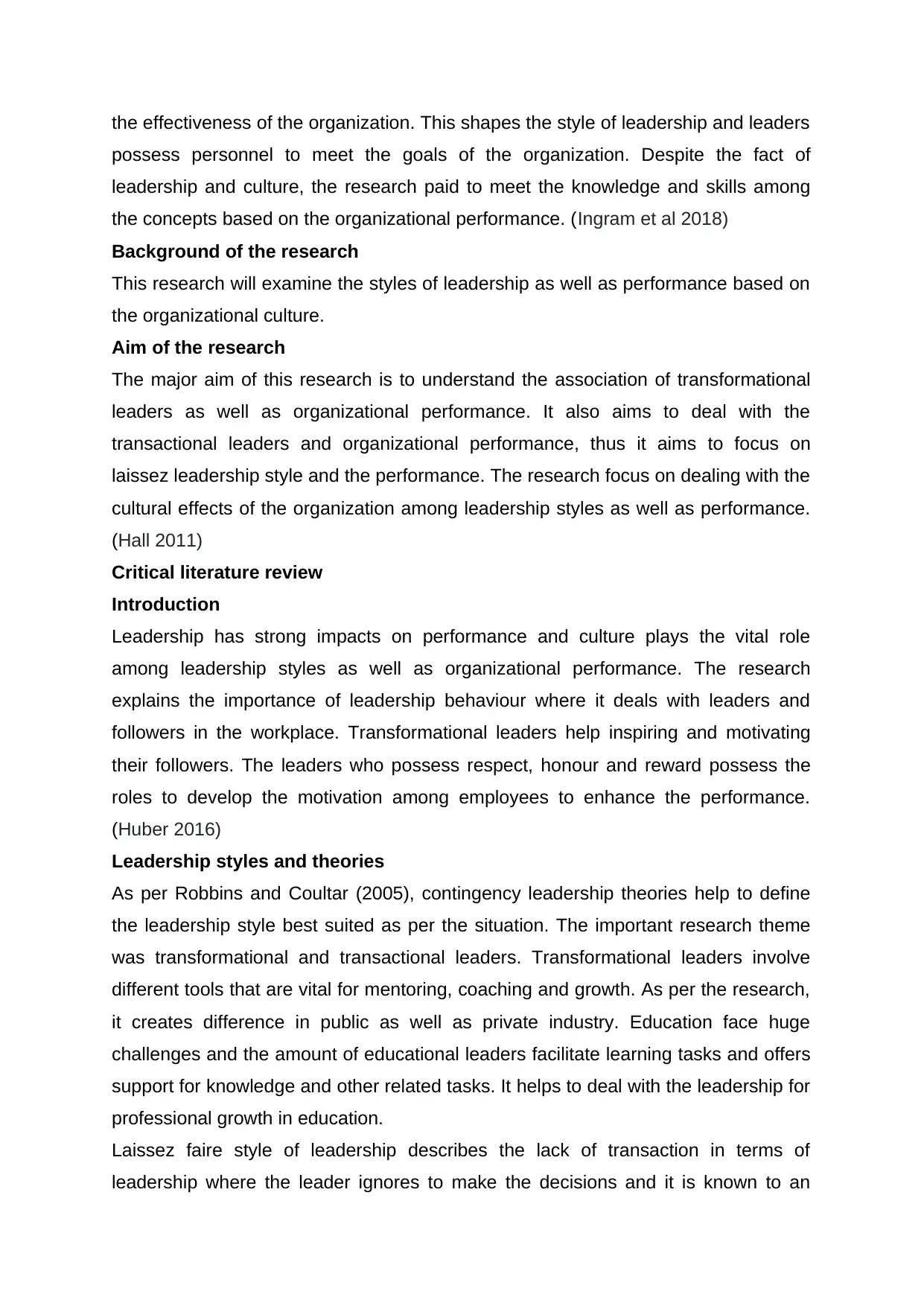
the effectiveness of the organization. This shapes the style of leadership and leaders
possess personnel to meet the goals of the organization. Despite the fact of
leadership and culture, the research paid to meet the knowledge and skills among
the concepts based on the organizational performance. (Ingram et al 2018)
Background of the research
This research will examine the styles of leadership as well as performance based on
the organizational culture.
Aim of the research
The major aim of this research is to understand the association of transformational
leaders as well as organizational performance. It also aims to deal with the
transactional leaders and organizational performance, thus it aims to focus on
laissez leadership style and the performance. The research focus on dealing with the
cultural effects of the organization among leadership styles as well as performance.
(Hall 2011)
Critical literature review
Introduction
Leadership has strong impacts on performance and culture plays the vital role
among leadership styles as well as organizational performance. The research
explains the importance of leadership behaviour where it deals with leaders and
followers in the workplace. Transformational leaders help inspiring and motivating
their followers. The leaders who possess respect, honour and reward possess the
roles to develop the motivation among employees to enhance the performance.
(Huber 2016)
Leadership styles and theories
As per Robbins and Coultar (2005), contingency leadership theories help to define
the leadership style best suited as per the situation. The important research theme
was transformational and transactional leaders. Transformational leaders involve
different tools that are vital for mentoring, coaching and growth. As per the research,
it creates difference in public as well as private industry. Education face huge
challenges and the amount of educational leaders facilitate learning tasks and offers
support for knowledge and other related tasks. It helps to deal with the leadership for
professional growth in education.
Laissez faire style of leadership describes the lack of transaction in terms of
leadership where the leader ignores to make the decisions and it is known to an
possess personnel to meet the goals of the organization. Despite the fact of
leadership and culture, the research paid to meet the knowledge and skills among
the concepts based on the organizational performance. (Ingram et al 2018)
Background of the research
This research will examine the styles of leadership as well as performance based on
the organizational culture.
Aim of the research
The major aim of this research is to understand the association of transformational
leaders as well as organizational performance. It also aims to deal with the
transactional leaders and organizational performance, thus it aims to focus on
laissez leadership style and the performance. The research focus on dealing with the
cultural effects of the organization among leadership styles as well as performance.
(Hall 2011)
Critical literature review
Introduction
Leadership has strong impacts on performance and culture plays the vital role
among leadership styles as well as organizational performance. The research
explains the importance of leadership behaviour where it deals with leaders and
followers in the workplace. Transformational leaders help inspiring and motivating
their followers. The leaders who possess respect, honour and reward possess the
roles to develop the motivation among employees to enhance the performance.
(Huber 2016)
Leadership styles and theories
As per Robbins and Coultar (2005), contingency leadership theories help to define
the leadership style best suited as per the situation. The important research theme
was transformational and transactional leaders. Transformational leaders involve
different tools that are vital for mentoring, coaching and growth. As per the research,
it creates difference in public as well as private industry. Education face huge
challenges and the amount of educational leaders facilitate learning tasks and offers
support for knowledge and other related tasks. It helps to deal with the leadership for
professional growth in education.
Laissez faire style of leadership describes the lack of transaction in terms of
leadership where the leader ignores to make the decisions and it is known to an
⊘ This is a preview!⊘
Do you want full access?
Subscribe today to unlock all pages.

Trusted by 1+ million students worldwide
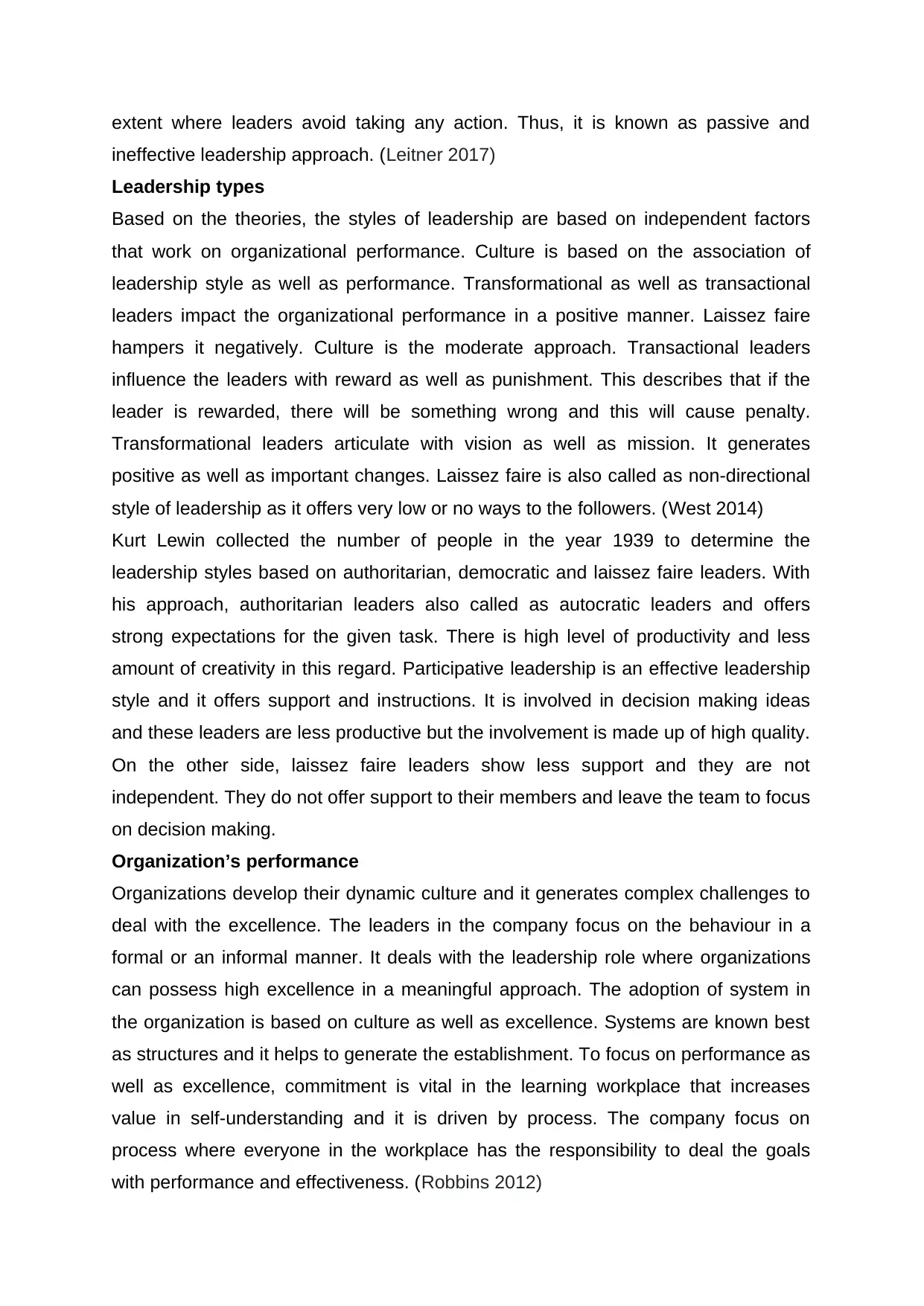
extent where leaders avoid taking any action. Thus, it is known as passive and
ineffective leadership approach. (Leitner 2017)
Leadership types
Based on the theories, the styles of leadership are based on independent factors
that work on organizational performance. Culture is based on the association of
leadership style as well as performance. Transformational as well as transactional
leaders impact the organizational performance in a positive manner. Laissez faire
hampers it negatively. Culture is the moderate approach. Transactional leaders
influence the leaders with reward as well as punishment. This describes that if the
leader is rewarded, there will be something wrong and this will cause penalty.
Transformational leaders articulate with vision as well as mission. It generates
positive as well as important changes. Laissez faire is also called as non-directional
style of leadership as it offers very low or no ways to the followers. (West 2014)
Kurt Lewin collected the number of people in the year 1939 to determine the
leadership styles based on authoritarian, democratic and laissez faire leaders. With
his approach, authoritarian leaders also called as autocratic leaders and offers
strong expectations for the given task. There is high level of productivity and less
amount of creativity in this regard. Participative leadership is an effective leadership
style and it offers support and instructions. It is involved in decision making ideas
and these leaders are less productive but the involvement is made up of high quality.
On the other side, laissez faire leaders show less support and they are not
independent. They do not offer support to their members and leave the team to focus
on decision making.
Organization’s performance
Organizations develop their dynamic culture and it generates complex challenges to
deal with the excellence. The leaders in the company focus on the behaviour in a
formal or an informal manner. It deals with the leadership role where organizations
can possess high excellence in a meaningful approach. The adoption of system in
the organization is based on culture as well as excellence. Systems are known best
as structures and it helps to generate the establishment. To focus on performance as
well as excellence, commitment is vital in the learning workplace that increases
value in self-understanding and it is driven by process. The company focus on
process where everyone in the workplace has the responsibility to deal the goals
with performance and effectiveness. (Robbins 2012)
ineffective leadership approach. (Leitner 2017)
Leadership types
Based on the theories, the styles of leadership are based on independent factors
that work on organizational performance. Culture is based on the association of
leadership style as well as performance. Transformational as well as transactional
leaders impact the organizational performance in a positive manner. Laissez faire
hampers it negatively. Culture is the moderate approach. Transactional leaders
influence the leaders with reward as well as punishment. This describes that if the
leader is rewarded, there will be something wrong and this will cause penalty.
Transformational leaders articulate with vision as well as mission. It generates
positive as well as important changes. Laissez faire is also called as non-directional
style of leadership as it offers very low or no ways to the followers. (West 2014)
Kurt Lewin collected the number of people in the year 1939 to determine the
leadership styles based on authoritarian, democratic and laissez faire leaders. With
his approach, authoritarian leaders also called as autocratic leaders and offers
strong expectations for the given task. There is high level of productivity and less
amount of creativity in this regard. Participative leadership is an effective leadership
style and it offers support and instructions. It is involved in decision making ideas
and these leaders are less productive but the involvement is made up of high quality.
On the other side, laissez faire leaders show less support and they are not
independent. They do not offer support to their members and leave the team to focus
on decision making.
Organization’s performance
Organizations develop their dynamic culture and it generates complex challenges to
deal with the excellence. The leaders in the company focus on the behaviour in a
formal or an informal manner. It deals with the leadership role where organizations
can possess high excellence in a meaningful approach. The adoption of system in
the organization is based on culture as well as excellence. Systems are known best
as structures and it helps to generate the establishment. To focus on performance as
well as excellence, commitment is vital in the learning workplace that increases
value in self-understanding and it is driven by process. The company focus on
process where everyone in the workplace has the responsibility to deal the goals
with performance and effectiveness. (Robbins 2012)
Paraphrase This Document
Need a fresh take? Get an instant paraphrase of this document with our AI Paraphraser
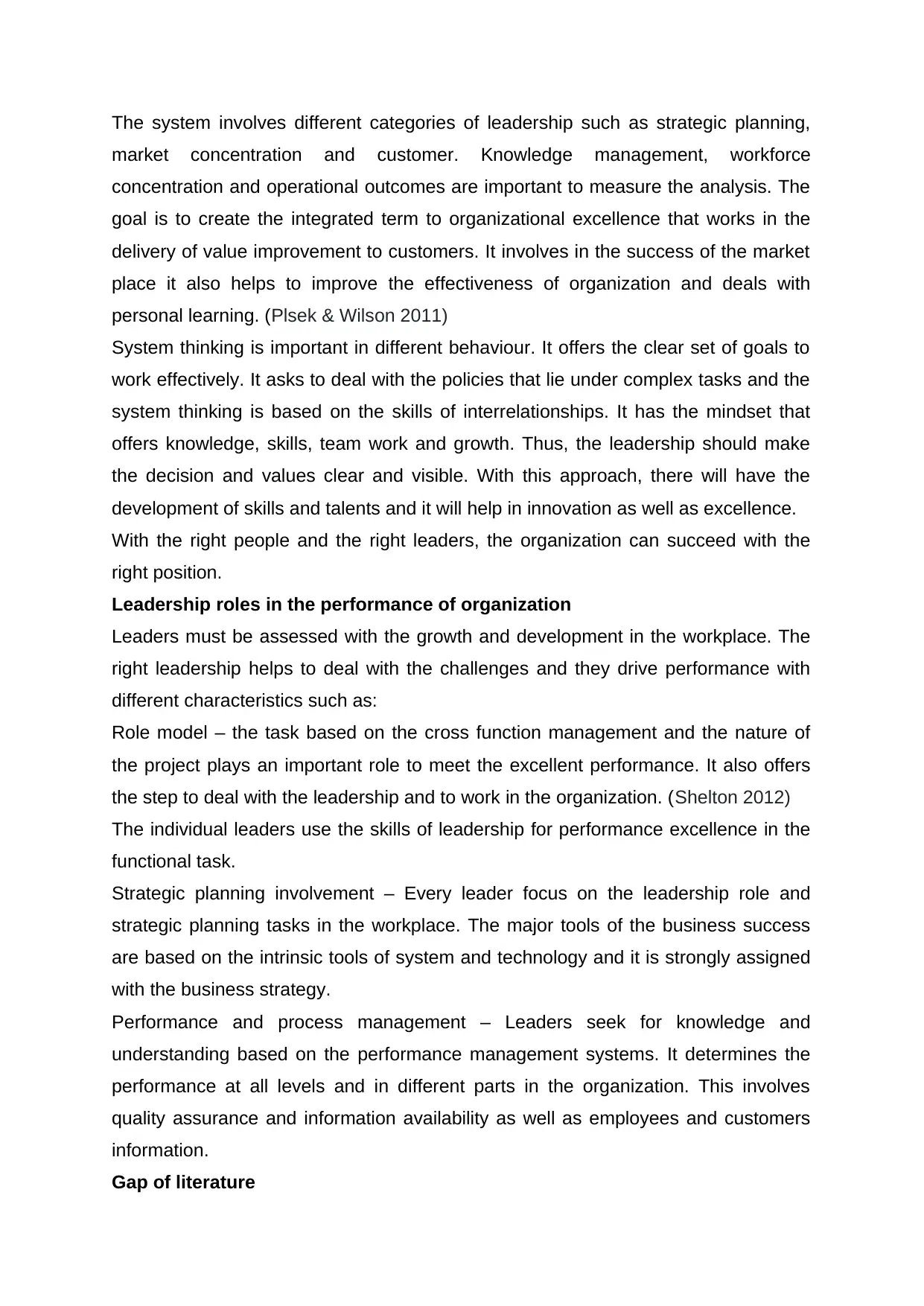
The system involves different categories of leadership such as strategic planning,
market concentration and customer. Knowledge management, workforce
concentration and operational outcomes are important to measure the analysis. The
goal is to create the integrated term to organizational excellence that works in the
delivery of value improvement to customers. It involves in the success of the market
place it also helps to improve the effectiveness of organization and deals with
personal learning. (Plsek & Wilson 2011)
System thinking is important in different behaviour. It offers the clear set of goals to
work effectively. It asks to deal with the policies that lie under complex tasks and the
system thinking is based on the skills of interrelationships. It has the mindset that
offers knowledge, skills, team work and growth. Thus, the leadership should make
the decision and values clear and visible. With this approach, there will have the
development of skills and talents and it will help in innovation as well as excellence.
With the right people and the right leaders, the organization can succeed with the
right position.
Leadership roles in the performance of organization
Leaders must be assessed with the growth and development in the workplace. The
right leadership helps to deal with the challenges and they drive performance with
different characteristics such as:
Role model – the task based on the cross function management and the nature of
the project plays an important role to meet the excellent performance. It also offers
the step to deal with the leadership and to work in the organization. (Shelton 2012)
The individual leaders use the skills of leadership for performance excellence in the
functional task.
Strategic planning involvement – Every leader focus on the leadership role and
strategic planning tasks in the workplace. The major tools of the business success
are based on the intrinsic tools of system and technology and it is strongly assigned
with the business strategy.
Performance and process management – Leaders seek for knowledge and
understanding based on the performance management systems. It determines the
performance at all levels and in different parts in the organization. This involves
quality assurance and information availability as well as employees and customers
information.
Gap of literature
market concentration and customer. Knowledge management, workforce
concentration and operational outcomes are important to measure the analysis. The
goal is to create the integrated term to organizational excellence that works in the
delivery of value improvement to customers. It involves in the success of the market
place it also helps to improve the effectiveness of organization and deals with
personal learning. (Plsek & Wilson 2011)
System thinking is important in different behaviour. It offers the clear set of goals to
work effectively. It asks to deal with the policies that lie under complex tasks and the
system thinking is based on the skills of interrelationships. It has the mindset that
offers knowledge, skills, team work and growth. Thus, the leadership should make
the decision and values clear and visible. With this approach, there will have the
development of skills and talents and it will help in innovation as well as excellence.
With the right people and the right leaders, the organization can succeed with the
right position.
Leadership roles in the performance of organization
Leaders must be assessed with the growth and development in the workplace. The
right leadership helps to deal with the challenges and they drive performance with
different characteristics such as:
Role model – the task based on the cross function management and the nature of
the project plays an important role to meet the excellent performance. It also offers
the step to deal with the leadership and to work in the organization. (Shelton 2012)
The individual leaders use the skills of leadership for performance excellence in the
functional task.
Strategic planning involvement – Every leader focus on the leadership role and
strategic planning tasks in the workplace. The major tools of the business success
are based on the intrinsic tools of system and technology and it is strongly assigned
with the business strategy.
Performance and process management – Leaders seek for knowledge and
understanding based on the performance management systems. It determines the
performance at all levels and in different parts in the organization. This involves
quality assurance and information availability as well as employees and customers
information.
Gap of literature
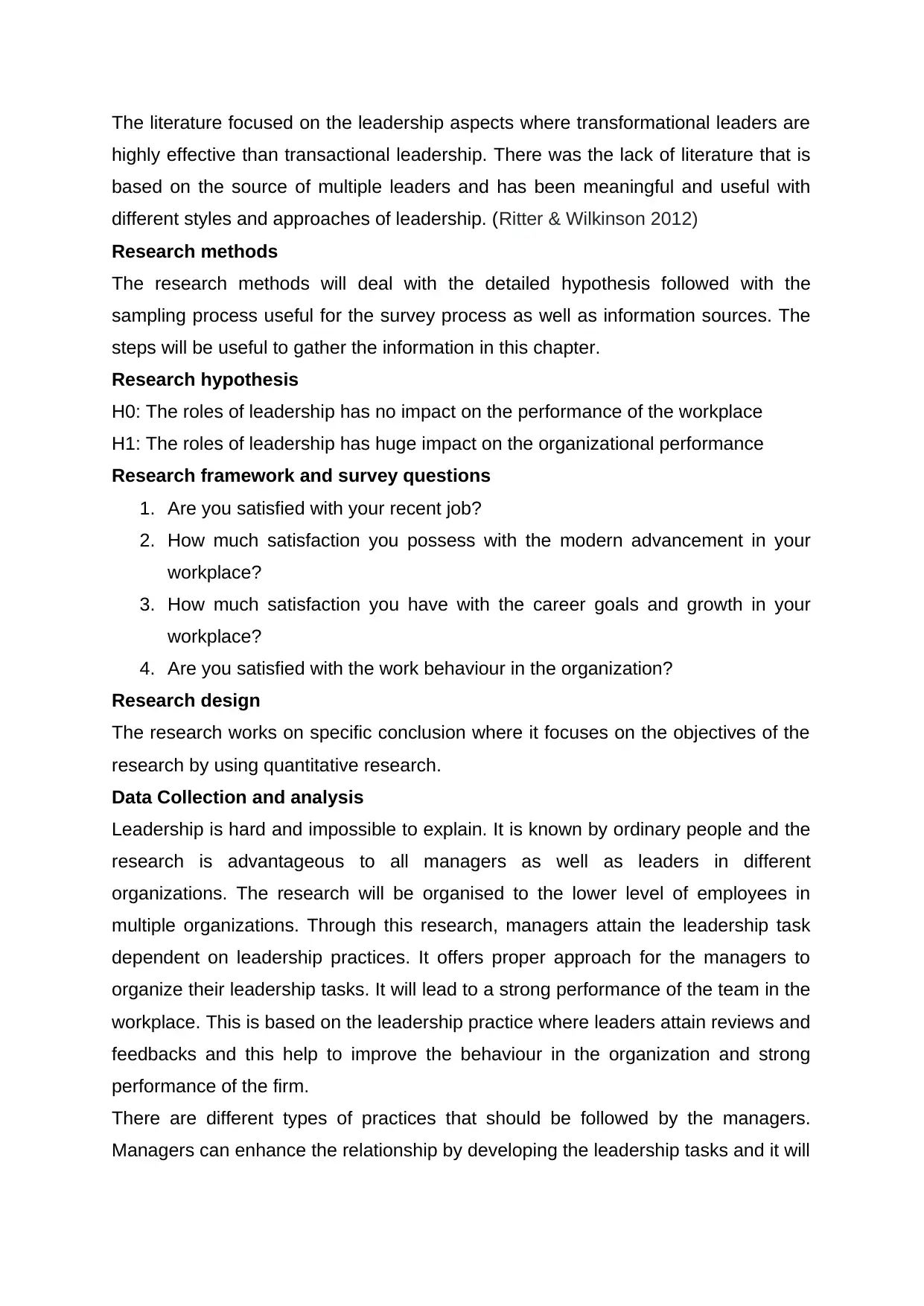
The literature focused on the leadership aspects where transformational leaders are
highly effective than transactional leadership. There was the lack of literature that is
based on the source of multiple leaders and has been meaningful and useful with
different styles and approaches of leadership. (Ritter & Wilkinson 2012)
Research methods
The research methods will deal with the detailed hypothesis followed with the
sampling process useful for the survey process as well as information sources. The
steps will be useful to gather the information in this chapter.
Research hypothesis
H0: The roles of leadership has no impact on the performance of the workplace
H1: The roles of leadership has huge impact on the organizational performance
Research framework and survey questions
1. Are you satisfied with your recent job?
2. How much satisfaction you possess with the modern advancement in your
workplace?
3. How much satisfaction you have with the career goals and growth in your
workplace?
4. Are you satisfied with the work behaviour in the organization?
Research design
The research works on specific conclusion where it focuses on the objectives of the
research by using quantitative research.
Data Collection and analysis
Leadership is hard and impossible to explain. It is known by ordinary people and the
research is advantageous to all managers as well as leaders in different
organizations. The research will be organised to the lower level of employees in
multiple organizations. Through this research, managers attain the leadership task
dependent on leadership practices. It offers proper approach for the managers to
organize their leadership tasks. It will lead to a strong performance of the team in the
workplace. This is based on the leadership practice where leaders attain reviews and
feedbacks and this help to improve the behaviour in the organization and strong
performance of the firm.
There are different types of practices that should be followed by the managers.
Managers can enhance the relationship by developing the leadership tasks and it will
highly effective than transactional leadership. There was the lack of literature that is
based on the source of multiple leaders and has been meaningful and useful with
different styles and approaches of leadership. (Ritter & Wilkinson 2012)
Research methods
The research methods will deal with the detailed hypothesis followed with the
sampling process useful for the survey process as well as information sources. The
steps will be useful to gather the information in this chapter.
Research hypothesis
H0: The roles of leadership has no impact on the performance of the workplace
H1: The roles of leadership has huge impact on the organizational performance
Research framework and survey questions
1. Are you satisfied with your recent job?
2. How much satisfaction you possess with the modern advancement in your
workplace?
3. How much satisfaction you have with the career goals and growth in your
workplace?
4. Are you satisfied with the work behaviour in the organization?
Research design
The research works on specific conclusion where it focuses on the objectives of the
research by using quantitative research.
Data Collection and analysis
Leadership is hard and impossible to explain. It is known by ordinary people and the
research is advantageous to all managers as well as leaders in different
organizations. The research will be organised to the lower level of employees in
multiple organizations. Through this research, managers attain the leadership task
dependent on leadership practices. It offers proper approach for the managers to
organize their leadership tasks. It will lead to a strong performance of the team in the
workplace. This is based on the leadership practice where leaders attain reviews and
feedbacks and this help to improve the behaviour in the organization and strong
performance of the firm.
There are different types of practices that should be followed by the managers.
Managers can enhance the relationship by developing the leadership tasks and it will
⊘ This is a preview!⊘
Do you want full access?
Subscribe today to unlock all pages.

Trusted by 1+ million students worldwide
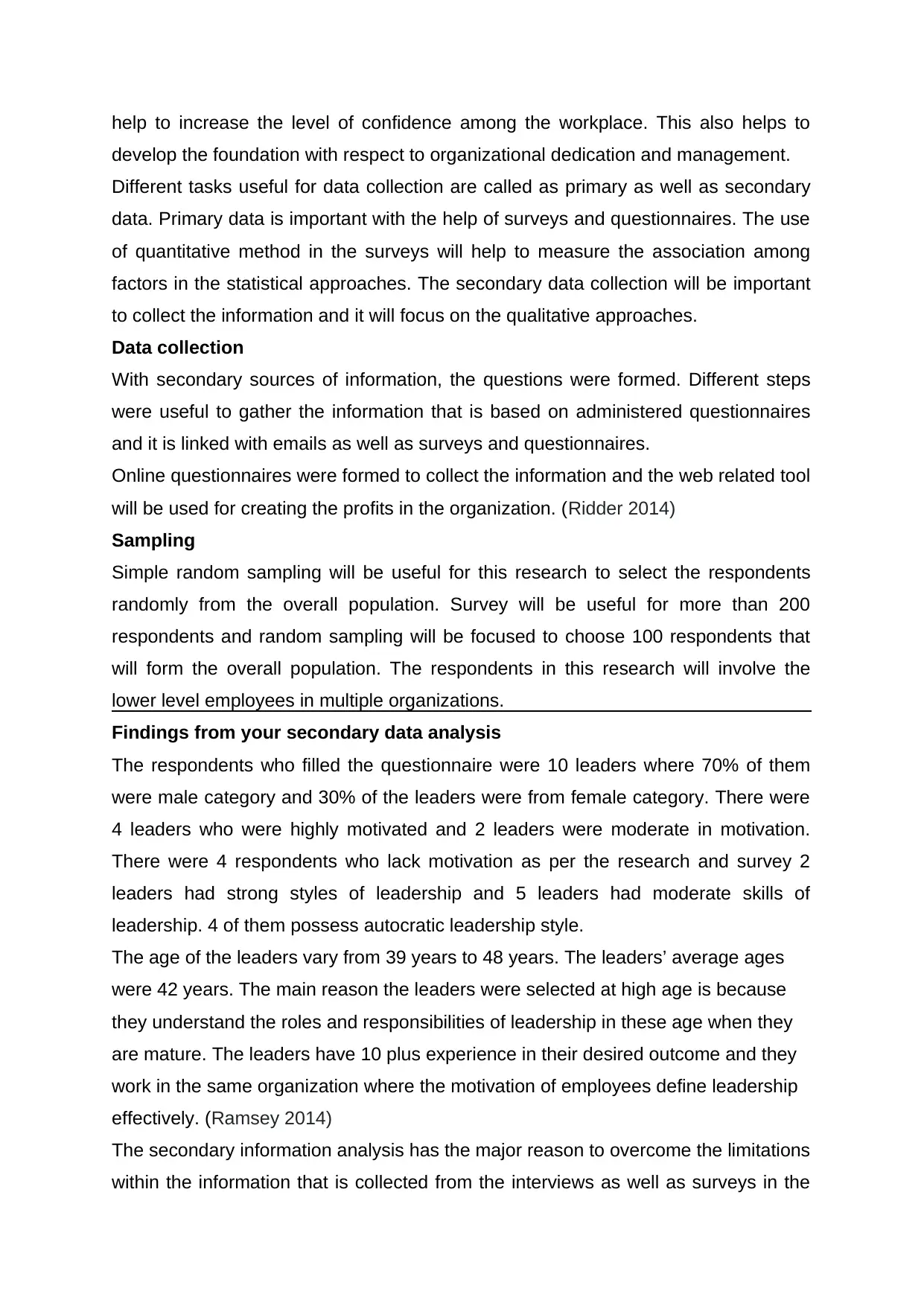
help to increase the level of confidence among the workplace. This also helps to
develop the foundation with respect to organizational dedication and management.
Different tasks useful for data collection are called as primary as well as secondary
data. Primary data is important with the help of surveys and questionnaires. The use
of quantitative method in the surveys will help to measure the association among
factors in the statistical approaches. The secondary data collection will be important
to collect the information and it will focus on the qualitative approaches.
Data collection
With secondary sources of information, the questions were formed. Different steps
were useful to gather the information that is based on administered questionnaires
and it is linked with emails as well as surveys and questionnaires.
Online questionnaires were formed to collect the information and the web related tool
will be used for creating the profits in the organization. (Ridder 2014)
Sampling
Simple random sampling will be useful for this research to select the respondents
randomly from the overall population. Survey will be useful for more than 200
respondents and random sampling will be focused to choose 100 respondents that
will form the overall population. The respondents in this research will involve the
lower level employees in multiple organizations.
Findings from your secondary data analysis
The respondents who filled the questionnaire were 10 leaders where 70% of them
were male category and 30% of the leaders were from female category. There were
4 leaders who were highly motivated and 2 leaders were moderate in motivation.
There were 4 respondents who lack motivation as per the research and survey 2
leaders had strong styles of leadership and 5 leaders had moderate skills of
leadership. 4 of them possess autocratic leadership style.
The age of the leaders vary from 39 years to 48 years. The leaders’ average ages
were 42 years. The main reason the leaders were selected at high age is because
they understand the roles and responsibilities of leadership in these age when they
are mature. The leaders have 10 plus experience in their desired outcome and they
work in the same organization where the motivation of employees define leadership
effectively. (Ramsey 2014)
The secondary information analysis has the major reason to overcome the limitations
within the information that is collected from the interviews as well as surveys in the
develop the foundation with respect to organizational dedication and management.
Different tasks useful for data collection are called as primary as well as secondary
data. Primary data is important with the help of surveys and questionnaires. The use
of quantitative method in the surveys will help to measure the association among
factors in the statistical approaches. The secondary data collection will be important
to collect the information and it will focus on the qualitative approaches.
Data collection
With secondary sources of information, the questions were formed. Different steps
were useful to gather the information that is based on administered questionnaires
and it is linked with emails as well as surveys and questionnaires.
Online questionnaires were formed to collect the information and the web related tool
will be used for creating the profits in the organization. (Ridder 2014)
Sampling
Simple random sampling will be useful for this research to select the respondents
randomly from the overall population. Survey will be useful for more than 200
respondents and random sampling will be focused to choose 100 respondents that
will form the overall population. The respondents in this research will involve the
lower level employees in multiple organizations.
Findings from your secondary data analysis
The respondents who filled the questionnaire were 10 leaders where 70% of them
were male category and 30% of the leaders were from female category. There were
4 leaders who were highly motivated and 2 leaders were moderate in motivation.
There were 4 respondents who lack motivation as per the research and survey 2
leaders had strong styles of leadership and 5 leaders had moderate skills of
leadership. 4 of them possess autocratic leadership style.
The age of the leaders vary from 39 years to 48 years. The leaders’ average ages
were 42 years. The main reason the leaders were selected at high age is because
they understand the roles and responsibilities of leadership in these age when they
are mature. The leaders have 10 plus experience in their desired outcome and they
work in the same organization where the motivation of employees define leadership
effectively. (Ramsey 2014)
The secondary information analysis has the major reason to overcome the limitations
within the information that is collected from the interviews as well as surveys in the
Paraphrase This Document
Need a fresh take? Get an instant paraphrase of this document with our AI Paraphraser
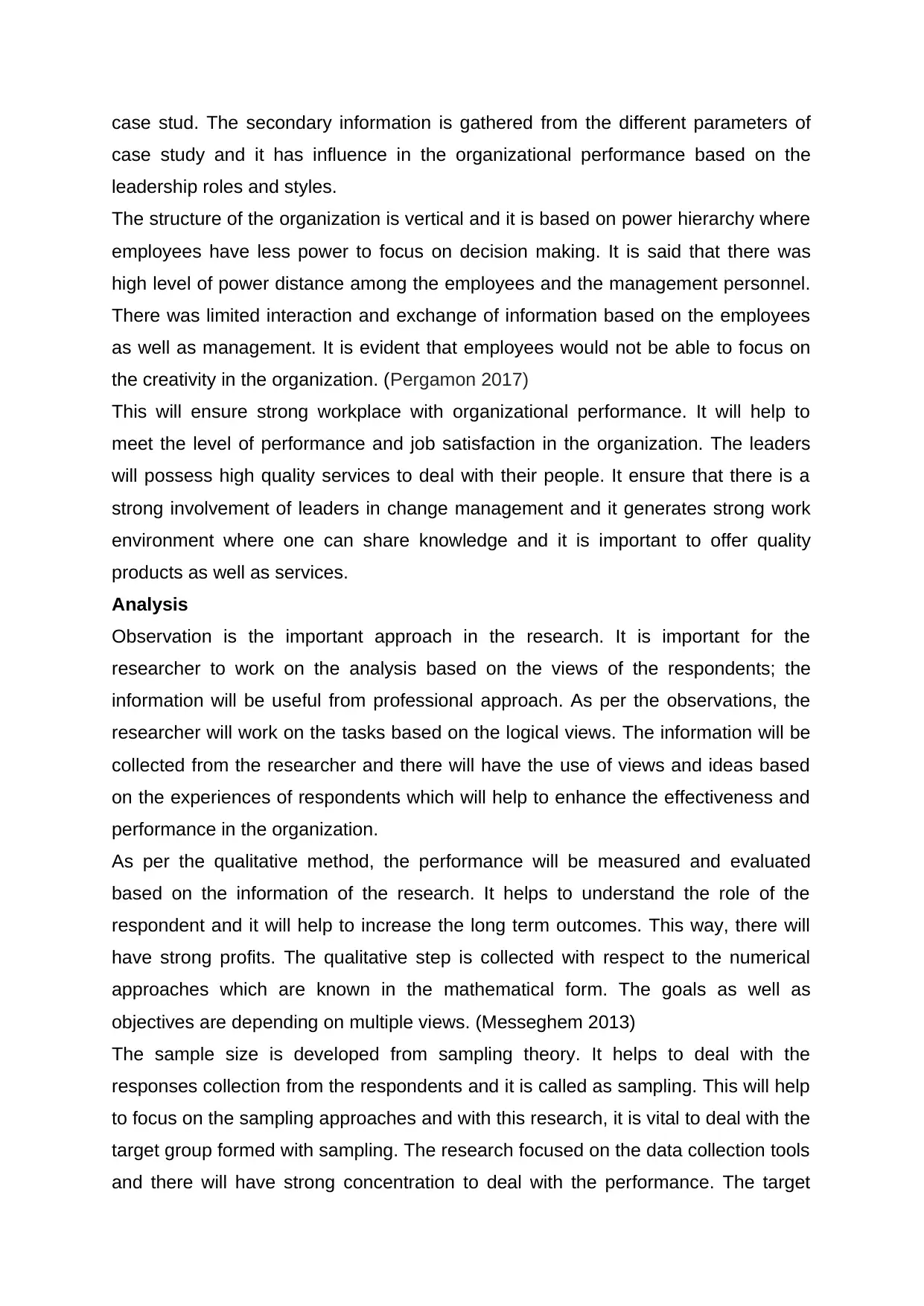
case stud. The secondary information is gathered from the different parameters of
case study and it has influence in the organizational performance based on the
leadership roles and styles.
The structure of the organization is vertical and it is based on power hierarchy where
employees have less power to focus on decision making. It is said that there was
high level of power distance among the employees and the management personnel.
There was limited interaction and exchange of information based on the employees
as well as management. It is evident that employees would not be able to focus on
the creativity in the organization. (Pergamon 2017)
This will ensure strong workplace with organizational performance. It will help to
meet the level of performance and job satisfaction in the organization. The leaders
will possess high quality services to deal with their people. It ensure that there is a
strong involvement of leaders in change management and it generates strong work
environment where one can share knowledge and it is important to offer quality
products as well as services.
Analysis
Observation is the important approach in the research. It is important for the
researcher to work on the analysis based on the views of the respondents; the
information will be useful from professional approach. As per the observations, the
researcher will work on the tasks based on the logical views. The information will be
collected from the researcher and there will have the use of views and ideas based
on the experiences of respondents which will help to enhance the effectiveness and
performance in the organization.
As per the qualitative method, the performance will be measured and evaluated
based on the information of the research. It helps to understand the role of the
respondent and it will help to increase the long term outcomes. This way, there will
have strong profits. The qualitative step is collected with respect to the numerical
approaches which are known in the mathematical form. The goals as well as
objectives are depending on multiple views. (Messeghem 2013)
The sample size is developed from sampling theory. It helps to deal with the
responses collection from the respondents and it is called as sampling. This will help
to focus on the sampling approaches and with this research, it is vital to deal with the
target group formed with sampling. The research focused on the data collection tools
and there will have strong concentration to deal with the performance. The target
case study and it has influence in the organizational performance based on the
leadership roles and styles.
The structure of the organization is vertical and it is based on power hierarchy where
employees have less power to focus on decision making. It is said that there was
high level of power distance among the employees and the management personnel.
There was limited interaction and exchange of information based on the employees
as well as management. It is evident that employees would not be able to focus on
the creativity in the organization. (Pergamon 2017)
This will ensure strong workplace with organizational performance. It will help to
meet the level of performance and job satisfaction in the organization. The leaders
will possess high quality services to deal with their people. It ensure that there is a
strong involvement of leaders in change management and it generates strong work
environment where one can share knowledge and it is important to offer quality
products as well as services.
Analysis
Observation is the important approach in the research. It is important for the
researcher to work on the analysis based on the views of the respondents; the
information will be useful from professional approach. As per the observations, the
researcher will work on the tasks based on the logical views. The information will be
collected from the researcher and there will have the use of views and ideas based
on the experiences of respondents which will help to enhance the effectiveness and
performance in the organization.
As per the qualitative method, the performance will be measured and evaluated
based on the information of the research. It helps to understand the role of the
respondent and it will help to increase the long term outcomes. This way, there will
have strong profits. The qualitative step is collected with respect to the numerical
approaches which are known in the mathematical form. The goals as well as
objectives are depending on multiple views. (Messeghem 2013)
The sample size is developed from sampling theory. It helps to deal with the
responses collection from the respondents and it is called as sampling. This will help
to focus on the sampling approaches and with this research, it is vital to deal with the
target group formed with sampling. The research focused on the data collection tools
and there will have strong concentration to deal with the performance. The target
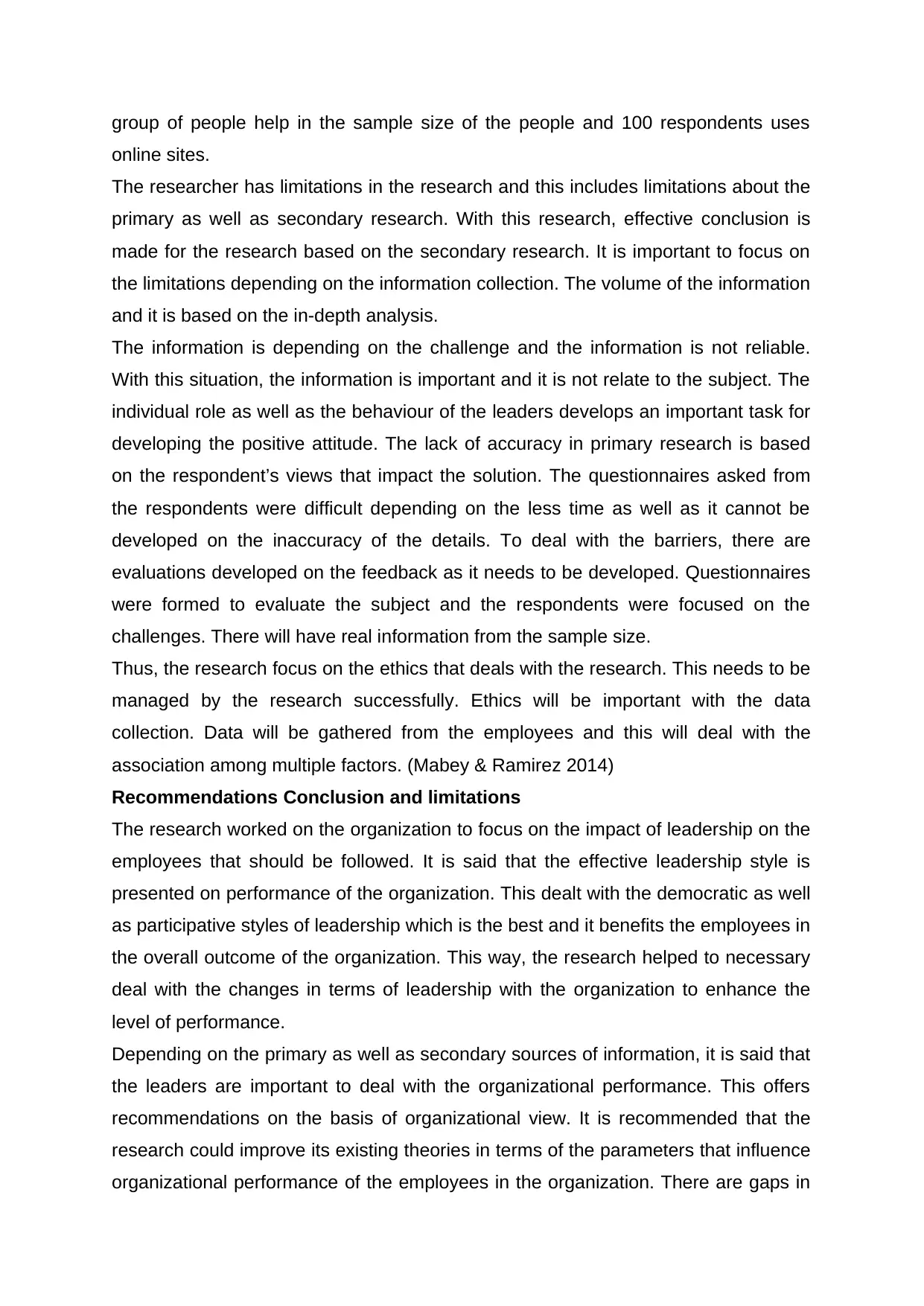
group of people help in the sample size of the people and 100 respondents uses
online sites.
The researcher has limitations in the research and this includes limitations about the
primary as well as secondary research. With this research, effective conclusion is
made for the research based on the secondary research. It is important to focus on
the limitations depending on the information collection. The volume of the information
and it is based on the in-depth analysis.
The information is depending on the challenge and the information is not reliable.
With this situation, the information is important and it is not relate to the subject. The
individual role as well as the behaviour of the leaders develops an important task for
developing the positive attitude. The lack of accuracy in primary research is based
on the respondent’s views that impact the solution. The questionnaires asked from
the respondents were difficult depending on the less time as well as it cannot be
developed on the inaccuracy of the details. To deal with the barriers, there are
evaluations developed on the feedback as it needs to be developed. Questionnaires
were formed to evaluate the subject and the respondents were focused on the
challenges. There will have real information from the sample size.
Thus, the research focus on the ethics that deals with the research. This needs to be
managed by the research successfully. Ethics will be important with the data
collection. Data will be gathered from the employees and this will deal with the
association among multiple factors. (Mabey & Ramirez 2014)
Recommendations Conclusion and limitations
The research worked on the organization to focus on the impact of leadership on the
employees that should be followed. It is said that the effective leadership style is
presented on performance of the organization. This dealt with the democratic as well
as participative styles of leadership which is the best and it benefits the employees in
the overall outcome of the organization. This way, the research helped to necessary
deal with the changes in terms of leadership with the organization to enhance the
level of performance.
Depending on the primary as well as secondary sources of information, it is said that
the leaders are important to deal with the organizational performance. This offers
recommendations on the basis of organizational view. It is recommended that the
research could improve its existing theories in terms of the parameters that influence
organizational performance of the employees in the organization. There are gaps in
online sites.
The researcher has limitations in the research and this includes limitations about the
primary as well as secondary research. With this research, effective conclusion is
made for the research based on the secondary research. It is important to focus on
the limitations depending on the information collection. The volume of the information
and it is based on the in-depth analysis.
The information is depending on the challenge and the information is not reliable.
With this situation, the information is important and it is not relate to the subject. The
individual role as well as the behaviour of the leaders develops an important task for
developing the positive attitude. The lack of accuracy in primary research is based
on the respondent’s views that impact the solution. The questionnaires asked from
the respondents were difficult depending on the less time as well as it cannot be
developed on the inaccuracy of the details. To deal with the barriers, there are
evaluations developed on the feedback as it needs to be developed. Questionnaires
were formed to evaluate the subject and the respondents were focused on the
challenges. There will have real information from the sample size.
Thus, the research focus on the ethics that deals with the research. This needs to be
managed by the research successfully. Ethics will be important with the data
collection. Data will be gathered from the employees and this will deal with the
association among multiple factors. (Mabey & Ramirez 2014)
Recommendations Conclusion and limitations
The research worked on the organization to focus on the impact of leadership on the
employees that should be followed. It is said that the effective leadership style is
presented on performance of the organization. This dealt with the democratic as well
as participative styles of leadership which is the best and it benefits the employees in
the overall outcome of the organization. This way, the research helped to necessary
deal with the changes in terms of leadership with the organization to enhance the
level of performance.
Depending on the primary as well as secondary sources of information, it is said that
the leaders are important to deal with the organizational performance. This offers
recommendations on the basis of organizational view. It is recommended that the
research could improve its existing theories in terms of the parameters that influence
organizational performance of the employees in the organization. There are gaps in
⊘ This is a preview!⊘
Do you want full access?
Subscribe today to unlock all pages.

Trusted by 1+ million students worldwide
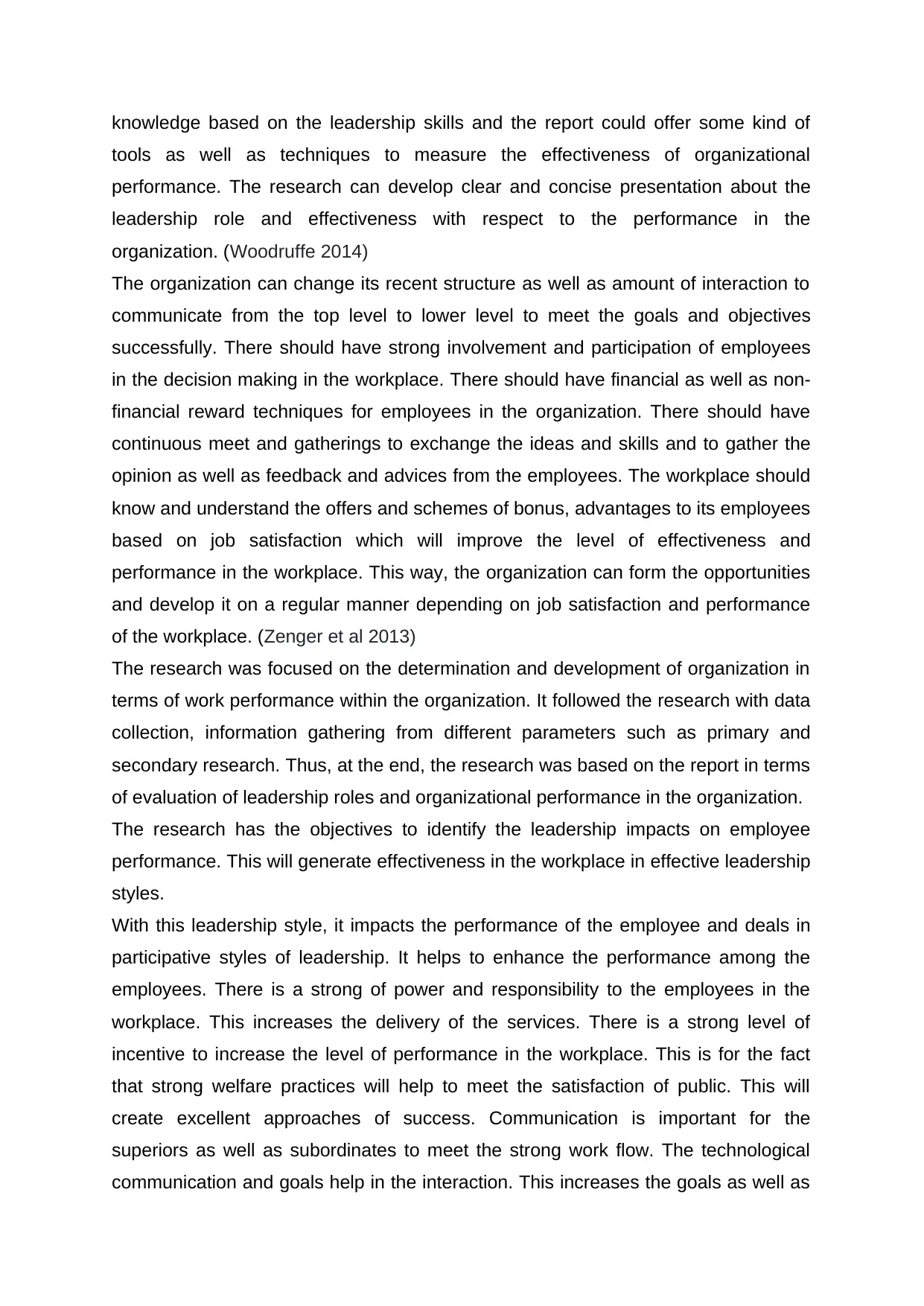
knowledge based on the leadership skills and the report could offer some kind of
tools as well as techniques to measure the effectiveness of organizational
performance. The research can develop clear and concise presentation about the
leadership role and effectiveness with respect to the performance in the
organization. (Woodruffe 2014)
The organization can change its recent structure as well as amount of interaction to
communicate from the top level to lower level to meet the goals and objectives
successfully. There should have strong involvement and participation of employees
in the decision making in the workplace. There should have financial as well as non-
financial reward techniques for employees in the organization. There should have
continuous meet and gatherings to exchange the ideas and skills and to gather the
opinion as well as feedback and advices from the employees. The workplace should
know and understand the offers and schemes of bonus, advantages to its employees
based on job satisfaction which will improve the level of effectiveness and
performance in the workplace. This way, the organization can form the opportunities
and develop it on a regular manner depending on job satisfaction and performance
of the workplace. (Zenger et al 2013)
The research was focused on the determination and development of organization in
terms of work performance within the organization. It followed the research with data
collection, information gathering from different parameters such as primary and
secondary research. Thus, at the end, the research was based on the report in terms
of evaluation of leadership roles and organizational performance in the organization.
The research has the objectives to identify the leadership impacts on employee
performance. This will generate effectiveness in the workplace in effective leadership
styles.
With this leadership style, it impacts the performance of the employee and deals in
participative styles of leadership. It helps to enhance the performance among the
employees. There is a strong of power and responsibility to the employees in the
workplace. This increases the delivery of the services. There is a strong level of
incentive to increase the level of performance in the workplace. This is for the fact
that strong welfare practices will help to meet the satisfaction of public. This will
create excellent approaches of success. Communication is important for the
superiors as well as subordinates to meet the strong work flow. The technological
communication and goals help in the interaction. This increases the goals as well as
tools as well as techniques to measure the effectiveness of organizational
performance. The research can develop clear and concise presentation about the
leadership role and effectiveness with respect to the performance in the
organization. (Woodruffe 2014)
The organization can change its recent structure as well as amount of interaction to
communicate from the top level to lower level to meet the goals and objectives
successfully. There should have strong involvement and participation of employees
in the decision making in the workplace. There should have financial as well as non-
financial reward techniques for employees in the organization. There should have
continuous meet and gatherings to exchange the ideas and skills and to gather the
opinion as well as feedback and advices from the employees. The workplace should
know and understand the offers and schemes of bonus, advantages to its employees
based on job satisfaction which will improve the level of effectiveness and
performance in the workplace. This way, the organization can form the opportunities
and develop it on a regular manner depending on job satisfaction and performance
of the workplace. (Zenger et al 2013)
The research was focused on the determination and development of organization in
terms of work performance within the organization. It followed the research with data
collection, information gathering from different parameters such as primary and
secondary research. Thus, at the end, the research was based on the report in terms
of evaluation of leadership roles and organizational performance in the organization.
The research has the objectives to identify the leadership impacts on employee
performance. This will generate effectiveness in the workplace in effective leadership
styles.
With this leadership style, it impacts the performance of the employee and deals in
participative styles of leadership. It helps to enhance the performance among the
employees. There is a strong of power and responsibility to the employees in the
workplace. This increases the delivery of the services. There is a strong level of
incentive to increase the level of performance in the workplace. This is for the fact
that strong welfare practices will help to meet the satisfaction of public. This will
create excellent approaches of success. Communication is important for the
superiors as well as subordinates to meet the strong work flow. The technological
communication and goals help in the interaction. This increases the goals as well as
Paraphrase This Document
Need a fresh take? Get an instant paraphrase of this document with our AI Paraphraser
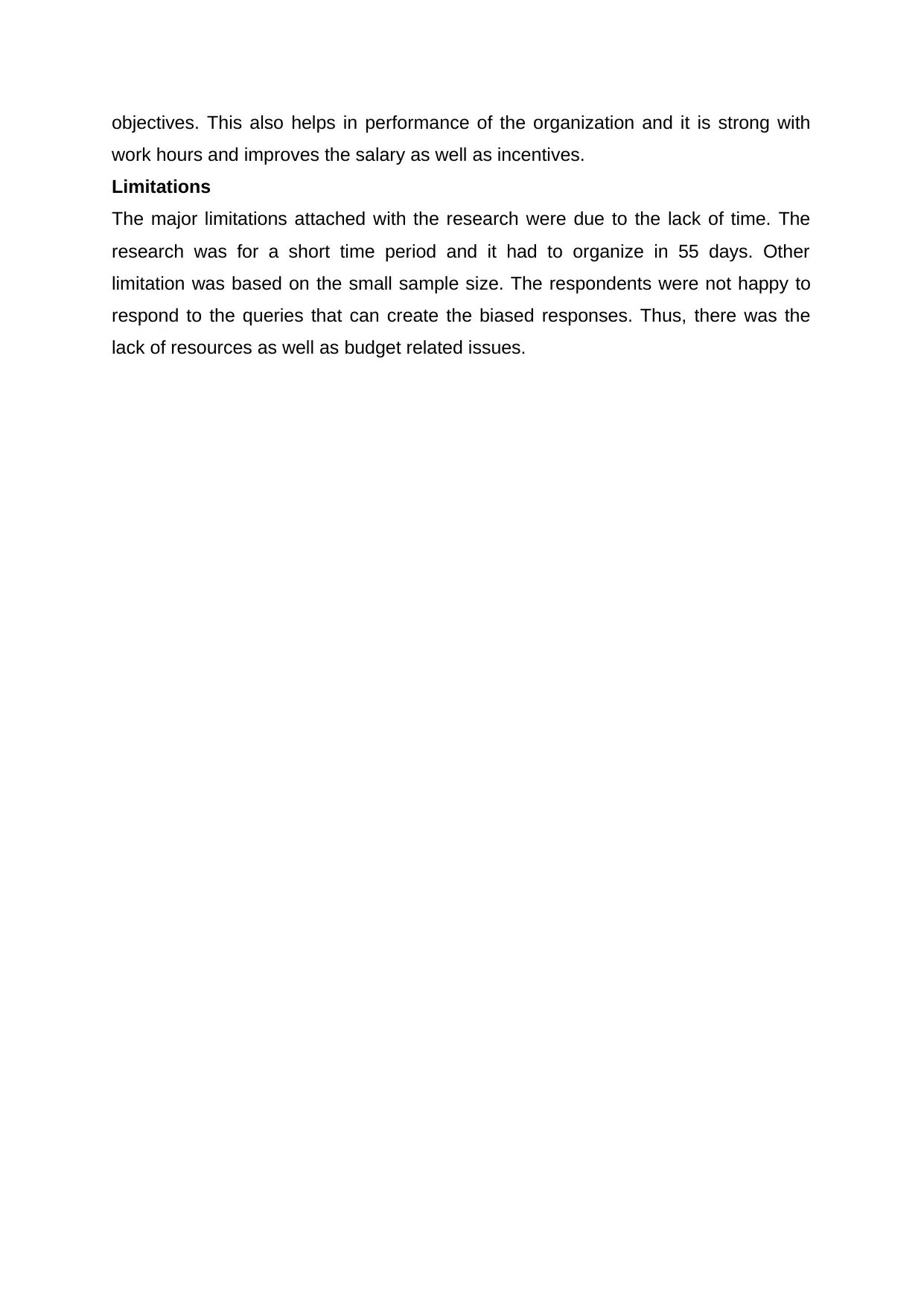
objectives. This also helps in performance of the organization and it is strong with
work hours and improves the salary as well as incentives.
Limitations
The major limitations attached with the research were due to the lack of time. The
research was for a short time period and it had to organize in 55 days. Other
limitation was based on the small sample size. The respondents were not happy to
respond to the queries that can create the biased responses. Thus, there was the
lack of resources as well as budget related issues.
work hours and improves the salary as well as incentives.
Limitations
The major limitations attached with the research were due to the lack of time. The
research was for a short time period and it had to organize in 55 days. Other
limitation was based on the small sample size. The respondents were not happy to
respond to the queries that can create the biased responses. Thus, there was the
lack of resources as well as budget related issues.
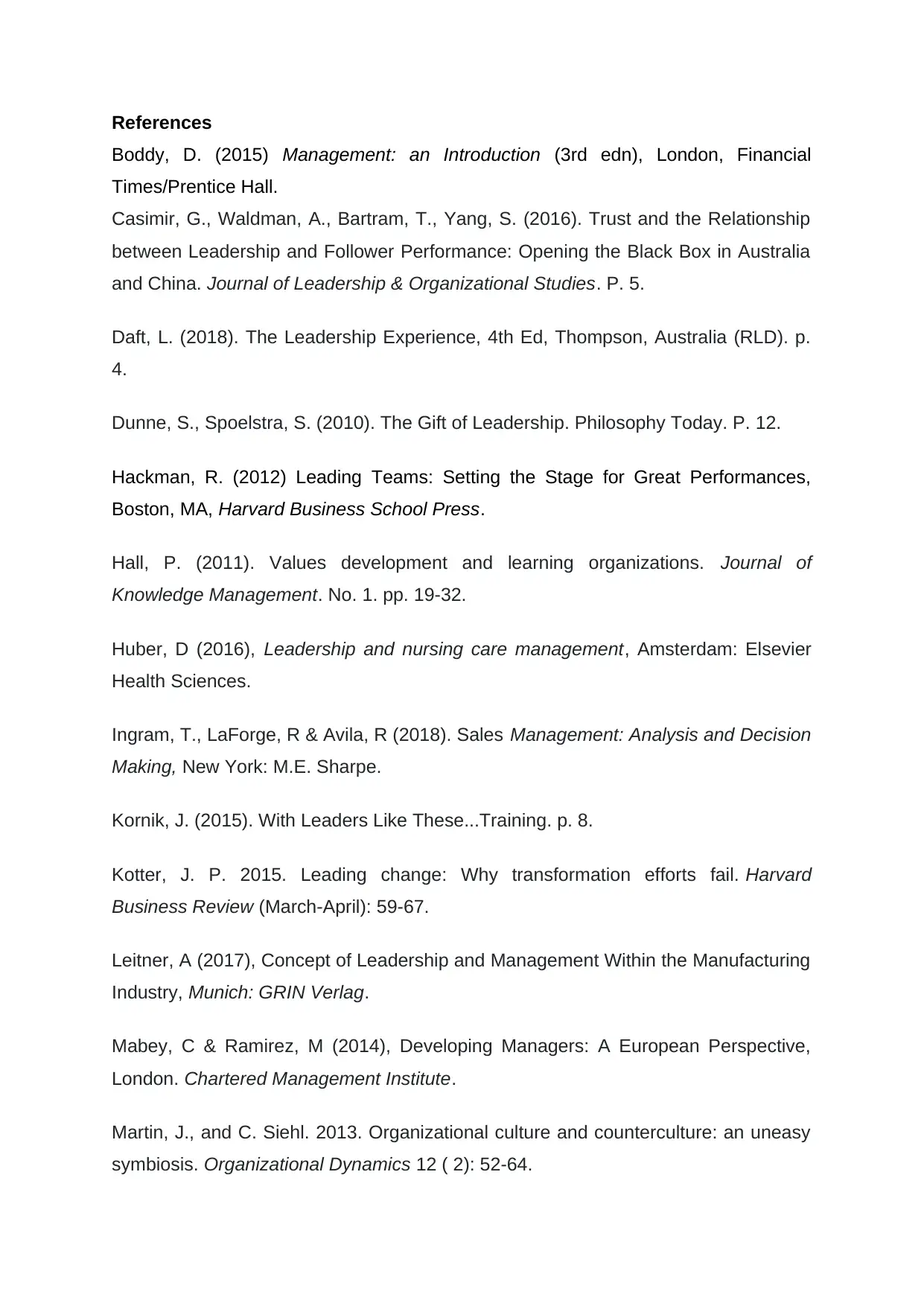
References
Boddy, D. (2015) Management: an Introduction (3rd edn), London, Financial
Times/Prentice Hall.
Casimir, G., Waldman, A., Bartram, T., Yang, S. (2016). Trust and the Relationship
between Leadership and Follower Performance: Opening the Black Box in Australia
and China. Journal of Leadership & Organizational Studies. P. 5.
Daft, L. (2018). The Leadership Experience, 4th Ed, Thompson, Australia (RLD). p.
4.
Dunne, S., Spoelstra, S. (2010). The Gift of Leadership. Philosophy Today. P. 12.
Hackman, R. (2012) Leading Teams: Setting the Stage for Great Performances,
Boston, MA, Harvard Business School Press.
Hall, P. (2011). Values development and learning organizations. Journal of
Knowledge Management. No. 1. pp. 19-32.
Huber, D (2016), Leadership and nursing care management, Amsterdam: Elsevier
Health Sciences.
Ingram, T., LaForge, R & Avila, R (2018). Sales Management: Analysis and Decision
Making, New York: M.E. Sharpe.
Kornik, J. (2015). With Leaders Like These...Training. p. 8.
Kotter, J. P. 2015. Leading change: Why transformation efforts fail. Harvard
Business Review (March-April): 59-67.
Leitner, A (2017), Concept of Leadership and Management Within the Manufacturing
Industry, Munich: GRIN Verlag.
Mabey, C & Ramirez, M (2014), Developing Managers: A European Perspective,
London. Chartered Management Institute.
Martin, J., and C. Siehl. 2013. Organizational culture and counterculture: an uneasy
symbiosis. Organizational Dynamics 12 ( 2): 52-64.
Boddy, D. (2015) Management: an Introduction (3rd edn), London, Financial
Times/Prentice Hall.
Casimir, G., Waldman, A., Bartram, T., Yang, S. (2016). Trust and the Relationship
between Leadership and Follower Performance: Opening the Black Box in Australia
and China. Journal of Leadership & Organizational Studies. P. 5.
Daft, L. (2018). The Leadership Experience, 4th Ed, Thompson, Australia (RLD). p.
4.
Dunne, S., Spoelstra, S. (2010). The Gift of Leadership. Philosophy Today. P. 12.
Hackman, R. (2012) Leading Teams: Setting the Stage for Great Performances,
Boston, MA, Harvard Business School Press.
Hall, P. (2011). Values development and learning organizations. Journal of
Knowledge Management. No. 1. pp. 19-32.
Huber, D (2016), Leadership and nursing care management, Amsterdam: Elsevier
Health Sciences.
Ingram, T., LaForge, R & Avila, R (2018). Sales Management: Analysis and Decision
Making, New York: M.E. Sharpe.
Kornik, J. (2015). With Leaders Like These...Training. p. 8.
Kotter, J. P. 2015. Leading change: Why transformation efforts fail. Harvard
Business Review (March-April): 59-67.
Leitner, A (2017), Concept of Leadership and Management Within the Manufacturing
Industry, Munich: GRIN Verlag.
Mabey, C & Ramirez, M (2014), Developing Managers: A European Perspective,
London. Chartered Management Institute.
Martin, J., and C. Siehl. 2013. Organizational culture and counterculture: an uneasy
symbiosis. Organizational Dynamics 12 ( 2): 52-64.
⊘ This is a preview!⊘
Do you want full access?
Subscribe today to unlock all pages.

Trusted by 1+ million students worldwide
1 out of 13
Related Documents
Your All-in-One AI-Powered Toolkit for Academic Success.
+13062052269
info@desklib.com
Available 24*7 on WhatsApp / Email
![[object Object]](/_next/static/media/star-bottom.7253800d.svg)
Unlock your academic potential
Copyright © 2020–2025 A2Z Services. All Rights Reserved. Developed and managed by ZUCOL.





